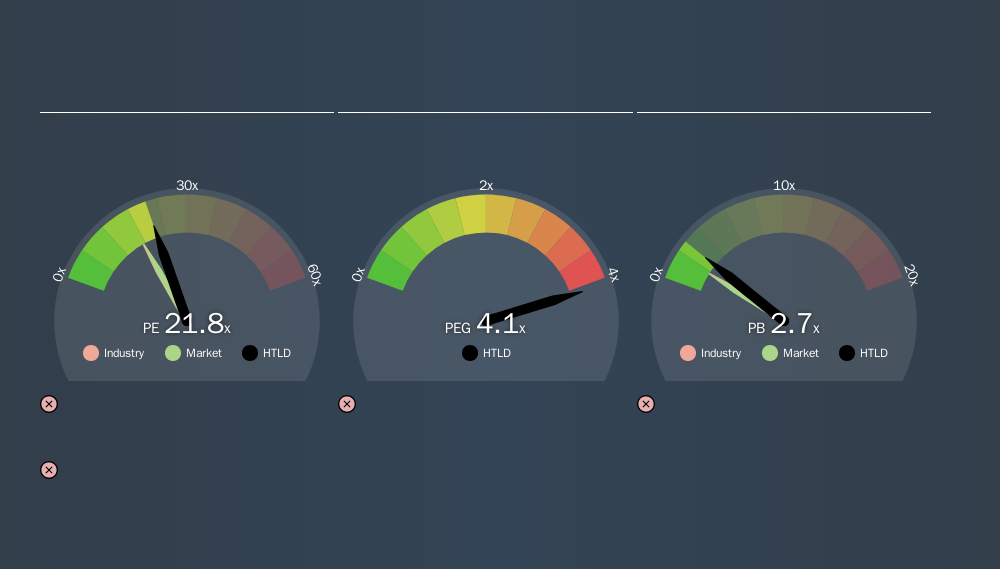- United States
- /
- Transportation
- /
- NasdaqGS:HTLD
Is Heartland Express, Inc.'s (NASDAQ:HTLD) High P/E Ratio A Problem For Investors?

This article is written for those who want to get better at using price to earnings ratios (P/E ratios). We'll apply a basic P/E ratio analysis to Heartland Express, Inc.'s (NASDAQ:HTLD), to help you decide if the stock is worth further research. Heartland Express has a price to earnings ratio of 21.76, based on the last twelve months. In other words, at today's prices, investors are paying $21.76 for every $1 in prior year profit.
View our latest analysis for Heartland Express
How Do I Calculate A Price To Earnings Ratio?
The formula for price to earnings is:
Price to Earnings Ratio = Share Price ÷ Earnings per Share (EPS)
Or for Heartland Express:
P/E of 21.76 = $21.56 ÷ $0.99 (Based on the trailing twelve months to June 2019.)
Is A High Price-to-Earnings Ratio Good?
A higher P/E ratio means that buyers have to pay a higher price for each $1 the company has earned over the last year. All else being equal, it's better to pay a low price -- but as Warren Buffett said, 'It's far better to buy a wonderful company at a fair price than a fair company at a wonderful price.'
How Does Heartland Express's P/E Ratio Compare To Its Peers?
We can get an indication of market expectations by looking at the P/E ratio. As you can see below, Heartland Express has a higher P/E than the average company (17.2) in the transportation industry.

Its relatively high P/E ratio indicates that Heartland Express shareholders think it will perform better than other companies in its industry classification.
How Growth Rates Impact P/E Ratios
Earnings growth rates have a big influence on P/E ratios. If earnings are growing quickly, then the 'E' in the equation will increase faster than it would otherwise. And in that case, the P/E ratio itself will drop rather quickly. A lower P/E should indicate the stock is cheap relative to others -- and that may attract buyers.
Heartland Express saw earnings per share improve by -5.9% last year. And it has bolstered its earnings per share by 3.5% per year over the last five years.
Remember: P/E Ratios Don't Consider The Balance Sheet
The 'Price' in P/E reflects the market capitalization of the company. Thus, the metric does not reflect cash or debt held by the company. Theoretically, a business can improve its earnings (and produce a lower P/E in the future) by investing in growth. That means taking on debt (or spending its cash).
Such expenditure might be good or bad, in the long term, but the point here is that the balance sheet is not reflected by this ratio.
So What Does Heartland Express's Balance Sheet Tell Us?
With net cash of US$206m, Heartland Express has a very strong balance sheet, which may be important for its business. Having said that, at 12% of its market capitalization the cash hoard would contribute towards a higher P/E ratio.
The Verdict On Heartland Express's P/E Ratio
Heartland Express's P/E is 21.8 which is above average (17.5) in its market. Recent earnings growth wasn't bad. And the net cash position provides the company with multiple options. The high P/E suggests the market thinks further growth will come.
Investors should be looking to buy stocks that the market is wrong about. If the reality for a company is better than it expects, you can make money by buying and holding for the long term. So this free visual report on analyst forecasts could hold the key to an excellent investment decision.
You might be able to find a better buy than Heartland Express. If you want a selection of possible winners, check out this free list of interesting companies that trade on a P/E below 20 (but have proven they can grow earnings).
We aim to bring you long-term focused research analysis driven by fundamental data. Note that our analysis may not factor in the latest price-sensitive company announcements or qualitative material.
If you spot an error that warrants correction, please contact the editor at editorial-team@simplywallst.com. This article by Simply Wall St is general in nature. It does not constitute a recommendation to buy or sell any stock, and does not take account of your objectives, or your financial situation. Simply Wall St has no position in the stocks mentioned. Thank you for reading.
About NasdaqGS:HTLD
Heartland Express
Operates as a short, medium, and long-haul truckload carrier and transportation services provider in the United States, Mexico, and Canada.
Fair value with moderate growth potential.
Market Insights
Community Narratives


